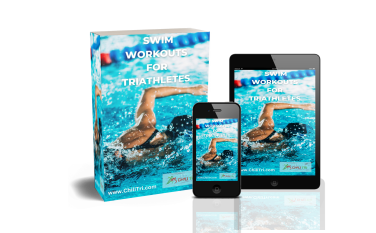Streamlined Swimming: Why Being a Harpoon is Better Than Being a Bullet in the Water
 Karen Parnell
October 04, 2024
Karen Parnell
October 04, 2024
Streamlined Swimming: Why Being a Harpoon is Better Than Being a Bullet in the Water
As a triathlete, swimmer, or coach, you know the importance of being fast in the water. But what if I told you that the key to cutting through the water like a pro isn’t just about raw strength or how hard you kick, but the shape of your body?
Think about this: if you’ve ever seen a bullet and a harpoon being shot underwater, you’ll notice something interesting.
The bullet, short and stubby, quickly slows down and doesn’t travel far, while the harpoon, long and streamlined, slices through the water and travels much farther.
Think about all those movies where the hero jumps in water to avoid being shot – this is not just Hollywood make believe but bullets do actually travel badly through water!
Why? It all comes down to physics and hydrodynamics.
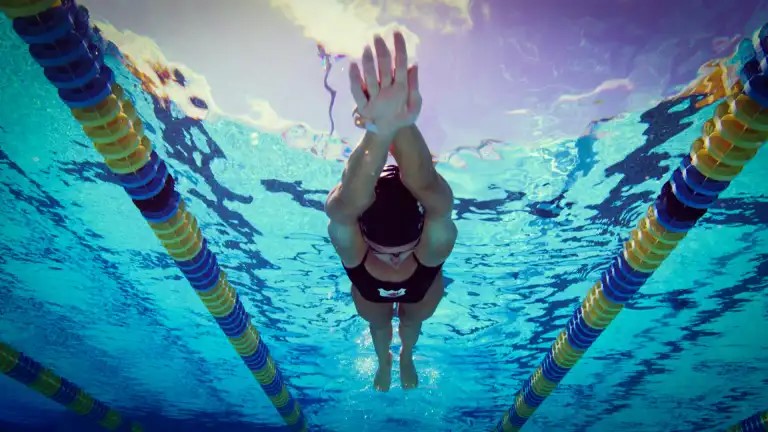
Source: The Race Club
Get your FREE Swim Workouts for Triathletes Book
Bullet vs. Harpoon: Hydrodynamics at Play
The Bullet’s Struggle in the Water
A bullet is designed to travel through air, which is much less dense than water (830 times less dense). When it enters the water, the bullet experiences a massive increase in drag—the force that opposes its motion.
The short, stubby shape of the bullet creates a lot of turbulence because it displaces water abruptly, leading to a large amount of frontal drag. Additionally, because of its compact shape, it lacks the length to create a streamlined flow of water around it.
Here’s what happens in simple terms: The bullet creates a "wall" of water in front of it, forcing it to slow down almost immediately upon impact. Its energy dissipates quickly, and it doesn’t travel far.
Bullets Travelling through the Water
When swimming freestyle, if your body is misaligned—head too high, hips dropping, or legs splaying out—you create unnecessary drag, much like a bullet in water. You’re essentially pushing against the water instead of gliding through it, wasting energy and slowing yourself down.

Bullet Swimming – Fighting the water!
Get your FREE Swim Workouts for Triathletes Book
The Harpoon’s Efficiency in Water
Now let’s look at the harpoon. Its long, streamlined shape is designed to minimize drag. When shot underwater, the water flows smoothly around the harpoon, creating less resistance and allowing it to travel much farther than the bullet.
The harpoon doesn’t "fight" the water; instead, it slips through it by making the smallest possible disturbance.
The harpoon’s length allows the water to part gently in front of it and rejoin behind it without creating much turbulence. This minimizes energy loss, allowing the harpoon to maintain its velocity for a longer period.
Slow Motion Speargun / Harpoon Firing
In swimming, adopting this harpoon-like streamlined shape is key to moving efficiently through the water. By keeping your body long, aligned, and narrow, you reduce drag and allow yourself to glide through the water with minimal resistance.
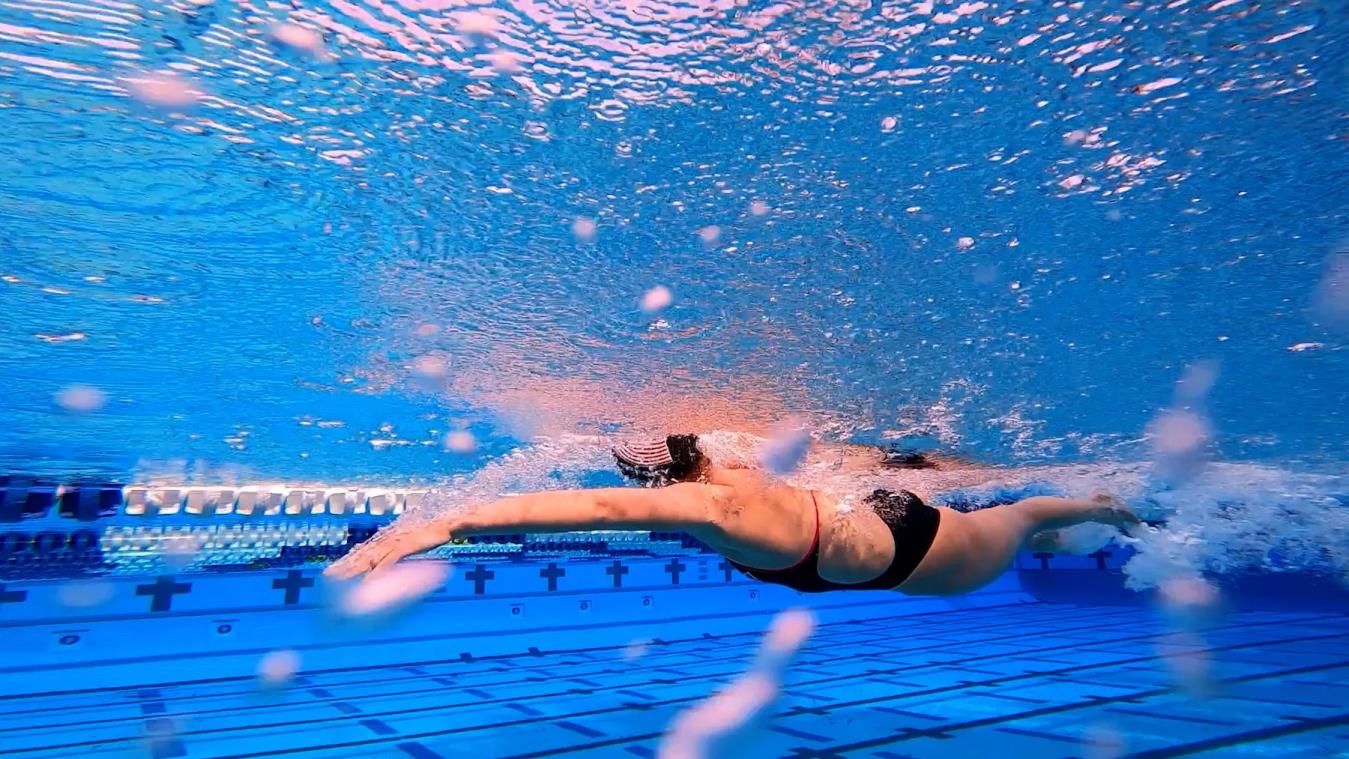
Katie Ledecky Swimming Like a Streamlined Harpoon Source: Washingtom Post
Get your FREE Swim Workouts for Triathletes Book
The Physics of Drag: Why Streamlining Matters
In swimming, drag comes from three main sources:
- Form drag – The resistance caused by the shape of your body. A compact or poorly aligned body (like high head and low hips) increases this type of drag.
- Friction drag – The resistance caused by the water sticking to your body as you move. A larger surface area (like splayed arms or legs) increases this drag.
- Wave drag – Resistance caused by the waves you generate, especially near the surface. Poor body position or thrashing as you kick can exaggerate wave creation.
To reduce all these types of drag, you need to streamline your body as much as possible—just like a harpoon. By elongating your body and minimizing disruptions in the water flow, you become more efficient and can travel farther with each stroke.
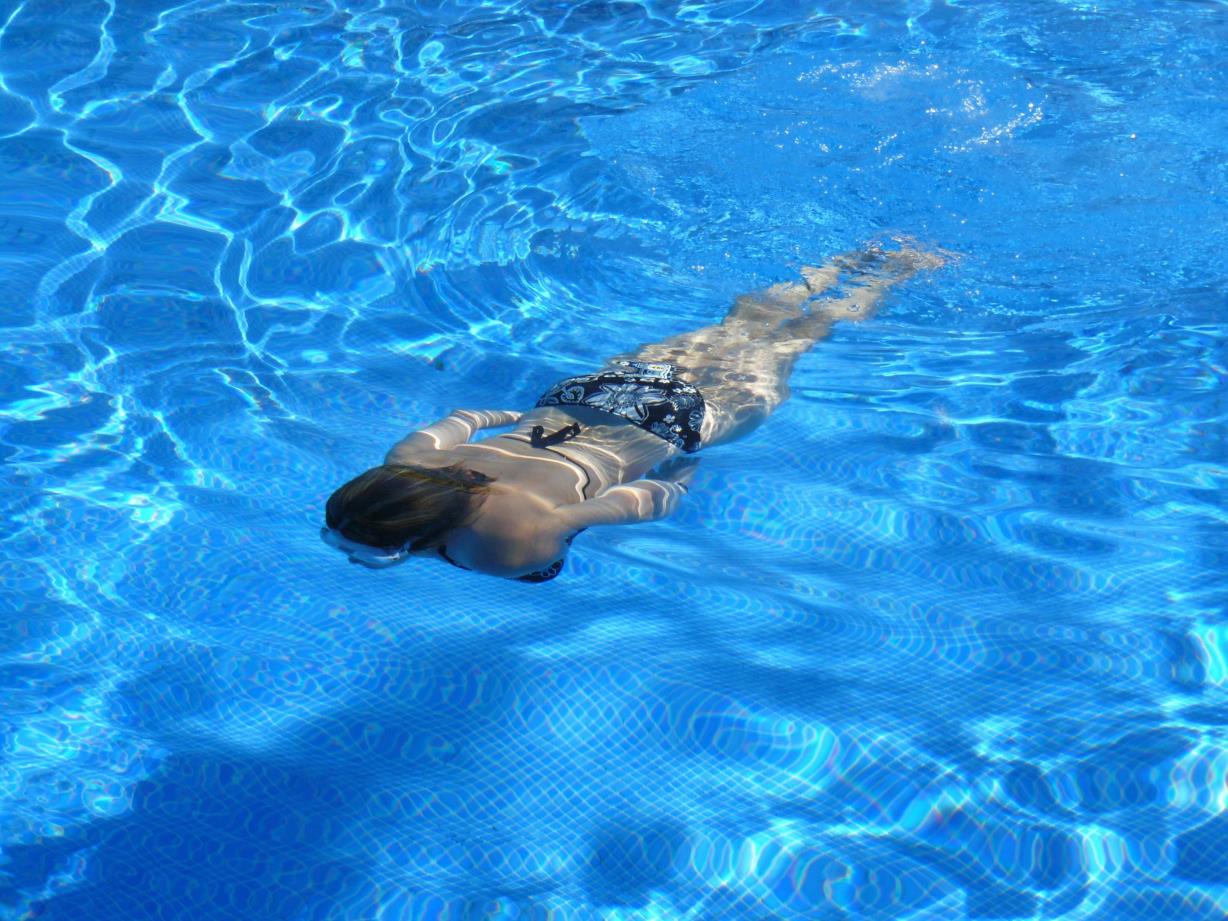
Photo by Pixabay
Translating This to Freestyle
When swimming freestyle, your goal is to create the least amount of resistance possible.
This means lengthening your body, keeping it straight, and minimizing unnecessary movements that disrupt your streamline.
You want to look and move like a harpoon—long and narrow, with your body slicing through the water.
Here’s what happens if you adopt a bullet-like position:
- Head too high or too low: This disrupts your body’s alignment, increasing frontal drag.
- Hips or legs sinking: If your legs drop, you’re essentially creating an anchor, slowing you down.
- Bent elbows or knees during the glide: Any bends in your body during the glide phase create turbulence and increase resistance.
- Arms and legs wide: If your arms or legs go wide during your arm stroke or your kick you are creating a parachute in the water and lots of drag slowing you down.
In contrast, by positioning yourself like a harpoon, you:
- Maintain a horizontal line, from head to toes, allowing the water to flow smoothly over your body.
- Keep your head in line with your spine, looking down or slightly forward, which helps keep your hips and legs up. Move your eyes to look forward rather than your head.
- Engage your core to maintain stability and prevent any excess movement or wiggling side-to-side.

Soure: Pixabay
Get your FREE Swim Workouts for Triathletes Book
Swim Through a "Hoop" – The Key to Better Body Position
Imagine swimming through a hoop that is just wide enough to fit your shoulders. To pass through this hoop cleanly, you need to keep your body narrow and aligned. If your legs splay out or your hips drop, you won’t fit through the hoop, and you’ll create extra drag.
Here's how to think about this:
- Kick: Keep your legs close together, with a slight, controlled flutter kick. Wide, scissor-like kicks will cause your legs to splay, adding drag. Visualize your feet staying within the boundaries of the "hoop." Try tapping your toes as you kick to ensure your legs are staying together.
- Hips: Engage your core to keep your hips in line with your shoulders. If your hips sink or twist, it’s like you’re expanding outside of the hoop, making it harder to move efficiently.
- Shoulders: As your hands extend forward in the freestyle stroke, your arms should stay in line with your shoulders, not flaring out. Imagine your whole body—from fingertips to toes—squeezing through that narrow hoop.
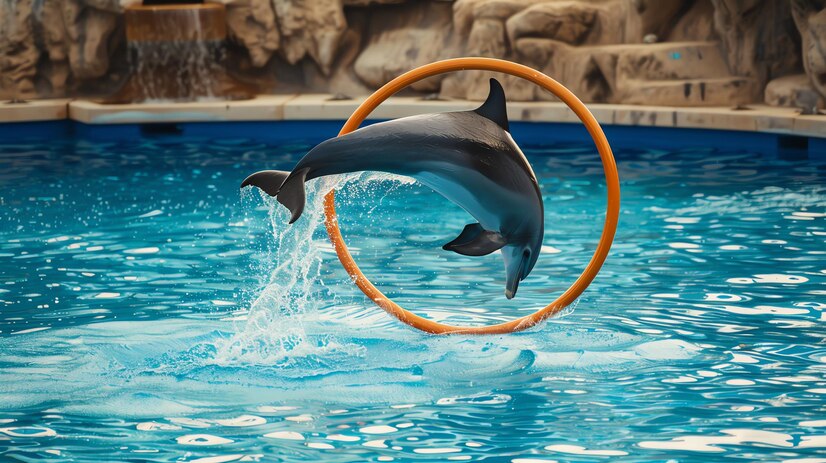
Get your FREE Swim Workouts for Triathletes Book
Drills to Improve Your Streamline and Body Position
Now that we’ve established why being a harpoon is better than being a bullet, let’s dive into how you can practice this in the water. Here are a few drills that can help improve your streamline and body position in freestyle:
- Push off the wall in a tight streamline position (arms extended, hands overlapping, head between your arms) and glide as far as you can without kicking.
- Focus on keeping your body long and straight, visualizing yourself moving through that narrow hoop.
- Engage your core to keep your hips up and legs in line with your body.
- Begin in a standing position and gently push off the wall with one arm extended forward and the other by your side, maintaining a horizontal body position.
- Switch arms every few strokes, focusing on keeping your core engaged and body flat.
- Think about squeezing through the imaginary hoop, with your arms staying narrow and your legs controlled.
- You can use fins if this helps.
- Swim on your side with one arm extended in front and the other by your side, kicking gently to stay afloat.
- Keep your body as narrow and streamlined as possible, imagining the hoop surrounding your shoulders, hips, and feet.
- This drill helps you practice balancing and staying aligned in a streamlined position.
- Swim freestyle but pause briefly with both arms extended in front of you before starting your next stroke.
- The idea here is to extend and elongate your body as much as possible between strokes, visualizing yourself fitting through that hoop with each movement.
- Swim with your arms at your sides and focus only on your body position. Your head should be in line with your spine, looking straight down, while your core keeps your hips and legs aligned. Kick your legs as normal.
- Again, think about maintaining that narrow, streamlined shape that would allow you to glide smoothly through the hoop.
For more information on the best swimming drills to improve your stroke read my Blog here.
Conclusion and Final Thoughts
In the world of triathlon and swimming, it’s not just about how strong or fast you are—it’s about how efficiently you move through the water. By being more like a harpoon and less like a bullet, you’ll swim faster, use less energy, and improve your overall performance.
Focus on streamlining your body, maintaining a straight, long shape in the water, and avoiding unnecessary drag.
Next time you hit the pool, visualize swimming through that narrow hoop and channel your inner harpoon. Keep practicing these drills, and you’ll find yourself slicing through the water with much more ease and speed.
Now, get out there, swim smart, and harpoon your way to success!
Karen Parnell is a Level 3 British Triathlon and IRONMAN Certified Coach, 8020 Endurance Certified Coach, WOWSA Level 3 open water swimming coach and NASM Personal Trainer and Sports Technology Writer.
Karen is currently studying for an MSc in Sports Performance Coaching at the University of Stirling.
Need a training plan? I have plans on TrainingPeaks and FinalSurge:
I also coach a very small number of athletes one to one for all triathlon and multi-sport distances, open water swimming events and running races, email me for details and availability. Karen.parnell@chilitri.com
Here’s a FREE Swim Workouts for Triathletes Book with swim workouts, tips, technique, drills, kit and terms.
FAQ: Streamlined Swimming – Why Being a Harpoon is Better Than Being a Bullet
1. Why is a harpoon better than a bullet when it comes to swimming?
A harpoon is long and streamlined, allowing it to slice through the water with minimal resistance. A bullet, on the other hand, is short and stubby, creating a lot of drag and turbulence, which causes it to slow down quickly. In swimming, having a long, narrow, and streamlined body position, like a harpoon, minimizes drag and allows you to move more efficiently through the water.
2. What is drag, and how does it affect my swimming?
Drag is the resistance you encounter as you move through the water. There are three main types of drag: form drag, friction drag, and wave drag. The more drag you create, the slower you’ll swim and the more energy you’ll waste. Streamlining your body (like a harpoon) reduces drag, allowing you to swim faster and with less effort.
3. Why doesn’t a bullet travel far underwater?
A bullet doesn’t travel far in water because its short, compact shape creates a lot of frontal drag. As it moves through the water, it displaces a lot of fluid in front of it, creating resistance that slows it down almost immediately. This is similar to poor swimming posture, where excess drag caused by misalignment or improper technique quickly tires you out.
4. How does a harpoon manage to travel farther in the water than a bullet?
A harpoon’s long, narrow, and streamlined shape allows water to flow smoothly around it, creating less resistance. It parts the water gently and reintroduces it behind with minimal turbulence, allowing it to maintain speed and travel farther than a bullet. This is the same principle you should aim for in swimming by keeping your body aligned and elongated in the water.
5. How can I improve my body position to reduce drag in freestyle swimming?
To reduce drag, focus on achieving a long, streamlined body position:
- Keep your head in line with your spine, looking down or slightly forward.
- Engage your core to keep your hips high and legs in line with your body.
- Keep your arms and legs close to your body, avoiding wide, splayed-out movements.
The goal is to visualize yourself moving through a narrow hoop, keeping your entire body aligned and minimizing unnecessary water displacement.
6. What does "swimming through a hoop" mean, and how does it help?
The “swimming through a hoop” analogy helps you focus on keeping your body as narrow and streamlined as possible. Imagine there’s a hoop just wide enough to fit your shoulders, and your goal is to swim through it without letting your body, legs, or arms flare outside that narrow space. This helps prevent excess drag by keeping your body aligned and streamlined.
7. What are some effective drills to help improve my streamline in the water?
Here are a few drills to help improve your body position and streamline:
- Streamline Glide Drill: Push off the wall and glide in a tight streamline position to practice body alignment.
- Superman Drill: Swim with one arm extended, focusing on lengthening your body.
- Kick on Side Drill: Swim on your side with one arm extended to practice balancing and keeping your body narrow.
- Catch-Up Drill: Pause briefly with both arms extended in front of you between strokes to work on lengthening your body.
- Head-Lead Balance Drill: Swim with your arms at your sides and focus solely on maintaining a flat, aligned body position.
8. How important is core engagement in maintaining a streamlined position?
Core engagement is critical for keeping your body aligned and streamlined. By engaging your core muscles, you prevent your hips and legs from sinking, which can cause drag and slow you down. A strong core helps you maintain a straight line from your head to your toes, allowing you to glide efficiently through the water.
9. What should I do if my legs or hips keep sinking while swimming?
If your legs or hips keep sinking, it’s likely a sign that your core isn’t engaged enough, or your head position is too high. Try looking straight down or slightly forward to help lift your hips. Also, practice core-strengthening exercises to build the muscles necessary to keep your body in a horizontal position.
10. How do I know if I’m creating too much drag while swimming?
Some signs that you’re creating too much drag include feeling like you’re working hard but not moving fast, or noticing a lot of splashing or turbulence around your body as you swim. If your legs or arms are wide, or your body is not aligned (head too high, hips sinking), you’re likely creating excess drag. Focus on streamlining your body position and reducing unnecessary movements to improve your efficiency.
11. How can these drills improve my swimming speed and endurance?
By practicing drills that help you streamline your body and reduce drag, you’ll swim faster with less effort. This improved efficiency means you’ll conserve energy, allowing you to maintain speed over longer distances without tiring out as quickly. Streamlining is one of the key techniques for improving both speed and endurance in swimming.
12. Why does my swimming technique matter more than strength in open water?
While strength is important, your technique (specifically your ability to reduce drag) plays a bigger role in your speed and efficiency in the water. Water is much denser than air, so poor technique creates more resistance and wastes more energy than on land. The more streamlined and efficient your body position, the faster and farther you’ll swim without tiring out.
References
Total Immersion: The Revolutionary Way to Swim Better, Faster, and Easier.
Science of Swimming Faster (Sport Science).
Yang J, Li T, Chen Z, Zuo C, Li X. Hydrodynamic Characteristics of Different Undulatory Underwater Swimming Positions Based on Multi-Body Motion Numerical Simulation Method. doi: 10.3390/ijerph182212263.
Rafa Aledo, Elche, Spain rafaaledo.com/filosofia-en-rafaaledo-com/

